In gearing up for this test, the project seemed simple at first. The logistics of collecting shotguns, shells, targets, and a measuring tape seemed simple. We cannot test every shell on the market, but we could test a range of buckshot sizes to gauge their performance. Then we would fire at the target for pattern and measure penetration. We could not use a single shotgun for this test, so for validity, we used two. Because we were testing function, one of the shotguns had to be a self-loader. The goal was to test buckshot for home defense and determine which load might be the best for Gun Tests readers to buy and try for themselves.
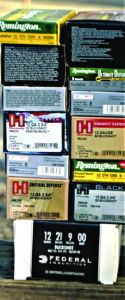
The ratings were another matter. The raters were somewhat split on what makes a good personal-defense loading. The primary rater, on taking notes and canvassing opinion, found two primary camps. The first was former or current peace officers and soldiers. The others were primarily hunters and those concerned with personal defense in the home. One might deploy the shotgun for emergency use in different situations and favored a cohesive pattern. The others were more liberal toward the pattern. The one side wanted a tight pattern to produce the most effect possible and produce good wound potential at 20 yards or more. With some loads, 30 yards might not be out of the question, if 50% of the pellets struck the target. The others had credible counter-arguments. What if the threat is behind cover and partially exposed? If you fire at a threat behind a tree, as an example, with only a hand and an eye exposed and firing at you, the larger pattern has a greater chance of snagging the opponent with a few pellets. Some of the loads, such as Winchester #4, exhibited a wide pattern, with the center fairly tight. It might deliver a hard blow with the center pattern, but also possibly connect with the outliers. History and events give us the most confidence in #00 buckshot, but we also tested mixed loads and #1, #4, and #000 shot. All the shells in the test were 12-gauge 2.75-inch shells except for one 3-inch Magnum by Sellier & Bellot, which we included as a power and shooting comfort reference.
How We Tested
Range is a consideration. One rater noted that 10 yards would be a long shot for his home. Another felt that 20 yards was possible on his property, but not inside the home. So, your choice depends on your situation, and if you are planning on using the shotgun as a primary weapon in a disaster zone, then the buckshot pattern should be as tight as possible for a longer effective shot. While it is possible to mix, one load for the home and one for the outdoors, if you are going to simplify and deploy one load, the tighter pattern wins. As one rater noted, however, the tighter the pattern, then perhaps you are defeating the purpose of the scattergun, and if the pattern is smaller than 4 to 6 inches at 10 yards, perhaps you need to re-think the association we have with shotguns as personal-defense firearms. In favor of the lighter weights of buckshot is less penetration in a home environment. All sides agree a miss is a hit somewhere because something will stop the shot. So, it is best to limit stray pieces of shot, both in their spread and how deeply the shot will penetrate materials common in the home. We considered all of the arguments, and the consensus favored a tighter pattern.
We measured patterns at 10 yards. This is a compromise between 7 yards as an engagement distance and 15 yards. We felt that at the 10-yard point, the pattern would have spread enough to offer an advantage in hitting a moving or running target, but it should still be fairly tight. In the text below, we report the width of the pattern first, then the height, in inches, such as 20 inches wide by 10 inches tall, or 20 by 10. In the accompanying table, the nomenclature is 20×10, width then height in inches.
We used two shotguns. A Remington 870 with an 18.5-inch barrel was the primarily test vehicle. We also included a Benelli M4 with 20-inch barrel. The Benelli uses choke tubes, and we tested with an open choke (designated Cylinder). While the results with this choke were interesting, we have learned that buckshot doesn’t always follow the rule with chokes. The Benelli was used as a litmus test of function in a self-loader. There were no failures to feed, chamber, fire, or eject, save for the frangible training load
We also tested penetration in water. Buckshot doesn’t travel in a giant spherical pattern as much as it flies in strings. Theoretically, some of the buckshot had busted the water jugs before all of the string behind made contact, so this isn’t a perfect test. But it is valid. We also calculated energy based on the common shot weight. Shot weight varies from maker to maker. As an example, #00 may be listed officially at 53.8 grains, but each pellet may range from 52 to 60 grains. If you are certain that the engagement will be static defense and that the range will be inside of 7 yards, none of the loads are at a particular disadvantage.
One of our raters has performed extensive buckshot testing in gelatin. He reports that once the shot hits gelatin, it radiates outward as much as 10%. This confirms one of our LEO raters’ impression of buckshot, and also his thought that buckshot seems to travel in pairs. We saw buckshot traveling in pairs, but we also saw one or two pellets far from the main course of travel. The placement of a 5- to 7-inch pattern on a man sized target may be counted on to connect with vital organs. When buckshot hit the water jugs, it continued to spread, because the pattern on the initial jug that was hit did not match the holes in the last jugs or the buckshot recovered.
We should note that a class of loading that many of us find ideal was originally developed to provide peace officers with less recoil than full-power 12 gauge but still offers good terminal ballistics. These reduced-recoil loads are beneficial for home defense. Some feature a tighter pattern to allow officers to engage threats at longer-than-average shotgun range. We don’t feel that decreasing velocity is a demerit for personal defense, if you consider that even the lightest of these loads exhibits two to three times the energy of most handgun calibers, including the 9mm and 45 ACP. As an example, the reduced-recoil Remington Managed Recoil loading is nearing 1200 foot-pounds of energy, while the full-power Remington Express load breaks more than 1700 foot pounds of energy. As for recoil, the platform makes a difference. The Benelli is gas operated and heavier than the pump action 870 used during the test. With some reduced-recoil loads, it was a joy to fire.
The bottom line is that along with power, the shotgun’s advantage is that it delivers a pattern that increases hit probability. The goal in game shooting is to place at least a few hits on a target and bring it down. Personal-defense shooters want all hits on target. Carefully consider your personal situation. In every case, pattern your own shotgun for individual results.
We should also mention that supply of these shells is extremely tight, and prices have sky-rocketed since we began this test. We haven’t included the original pricing for the shotshells because they were acquired pre-pandemic, when prices were a lot more normal. We did keep in mentions of rounds that were more affordable at the time of purchase because they will likely be so once again at some point in the future.
Spot-checks we did recently showed almost all of the loads to be out of stock, but that can change minute to minute. So if you find a recommended load in stock, we advise being ready to buy some immediately, if you can stomach the cost.
Buckshot Dimensions
This size chart shows the caliber and average weight of individual pieces of buckshot. The actual weight per piece will vary. These weights were used to calculate energy output in the following tables.| Shot Size | Diameter | Weight |
|---|---|---|
| #4 | 0.24 in. | 20.6 grains |
| #1 | 0.30 in. | 40.0 grains |
| #00 | 0.34 in. | 53.8 grains |
| #000 | 0.36 in. | 68.0 grains |
Test Procedure
We fired three examples of each shell to check the pattern and fired at least 15 shells of each type in fast combat shooting and function testing. We found recoil is a consideration. We fired several shells in re-testing patterns and a minimum of 10 shells of each type to test function in the self-loader. Few loads were fired in less than 25 quantity, save for one noted as almost unavailable. The pattern size is simply the group size of the pellets that struck on the target.
The spread is measured from the center to the center of the most widely spread holes in the target. The shooter should carefully pattern his own shotgun to determine its efficiency at the likely defensive range. Shotguns vary in pattern even when they have the same choke. Our primary rater summed it up: for service use, he likes a very tight pattern as close to one hole as possible out to 20 feet, and at 50 feet, the pattern should be the size of the cranium, with just a few impacts off center. At 75 feet, the pattern should stay in the K zone of a human-size paper target.
GUN TESTS GRADE: A (OUR PICK)
Remington Managed-Recoil #00 Buckshot RL12BK00
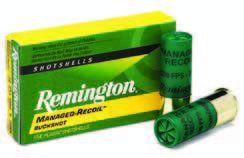
This is an eight-pellet load. Reducing the payload by one pellet may tighten the pattern and also reduce recoil. This is a reduced-recoil load at 1109 fps in the Remington 870. The pattern was superb, without any drawbacks, at 1.8 by 1.5 inches. The Benelli gained 5 fps over the pumpgun’s velocity and put all eight pellets into 1.7 by 1.6 inches. Basically, patterns were identical in each shotgun. This was an affordable load at the time of purchase, but was nonetheless high quality and feed reliable in the Benelli and a first-class performer.
GUN TESTS GRADE: A
Hornady Critical Defense #00 Buckshot 86240
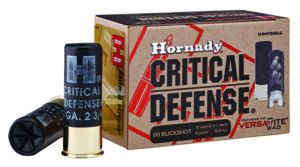 The Critical Defense is a full-power load. There are advantages in a 1254-fps load in penetration and energy. The balls landed in a 4-by 3-inch pattern. This is good performance for a full-power loading. In the Benelli, the loading sent all eight balls into a 4.5-by-2.8-inch group, statistically little different from the pumpgun. If you are looking for a full-power loading, this one works well. Some of the raters noticed the difference in recoil between this and the reduced recoil load in the Benelli, and some did not.
The Critical Defense is a full-power load. There are advantages in a 1254-fps load in penetration and energy. The balls landed in a 4-by 3-inch pattern. This is good performance for a full-power loading. In the Benelli, the loading sent all eight balls into a 4.5-by-2.8-inch group, statistically little different from the pumpgun. If you are looking for a full-power loading, this one works well. Some of the raters noticed the difference in recoil between this and the reduced recoil load in the Benelli, and some did not.
GUN TESTS GRADE: A
Hornady American Gunner #00 Buckshot 86274
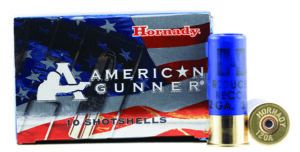 This was an affordable load in the 10-shell box. The American Gunner is an affordable option and a reduced-recoil load. This load is lighter than the Critical Defense load, but not as light as the Remington Managed Recoil loading. At 1226 fps, the American Gunner delivered a pattern of 4 by 5.5 inches. Interestingly, seven of the buckshot balls went into a group measuring 4 by 3 inches consistently, and the eighth ball opened the group. The effect was more pronounced in the Benelli, with seven balls in 4 by 4 inches, with the eighth lonely pellet opening the group to 4 by 7.5 inches. The balance of power and pattern is excellent.
This was an affordable load in the 10-shell box. The American Gunner is an affordable option and a reduced-recoil load. This load is lighter than the Critical Defense load, but not as light as the Remington Managed Recoil loading. At 1226 fps, the American Gunner delivered a pattern of 4 by 5.5 inches. Interestingly, seven of the buckshot balls went into a group measuring 4 by 3 inches consistently, and the eighth ball opened the group. The effect was more pronounced in the Benelli, with seven balls in 4 by 4 inches, with the eighth lonely pellet opening the group to 4 by 7.5 inches. The balance of power and pattern is excellent.
GUN TESTS GRADE: A
Hornady Black #00 Buckshot 86249
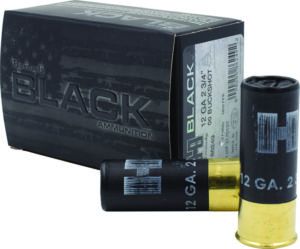
The Hornady Black is a full-power shotshell that pushes eight #00 buckshot pellets to 1270 fps. There is recoil and muzzle blast, but the load is controllable. The pattern was very good — six pellets in a group measuring 3 by 1 inches. The other two pellets made for a 3-by-5-inch pattern. The Benelli fared less well, but still shot very well, with a 3-by-2-inch pattern for six pellets and 3 by 7 for all eight balls at 1290 fps. This load hits hard and offers good reliability.
GUN TESTS GRADE: A
Federal Ammunition #00 Buckshot XLE132-00
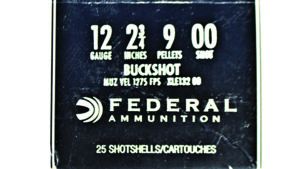
This load has been around a long time and has developed a good reputation. It isn’t too hot and it isn’t too light, and it uses the original nine-00-buckshot-pellet payload. The pattern was excellent during our 10-yard test. We measured an average of 3 by 1.5 inches in the 870 at 1233 fps. In the Benelli, results were similar with a 3.8-by-3 pattern at 1248 fps.
GUN TESTS GRADE: A
Winchester Razorback XT #00 Buckshot S12RB00
This is an eight-pellet 00 buckshot load intended for hunting use in areas that prohibit rifles. While we prefer slugs for something as large as a hog, at moderate range this load should be effective. Velocity averaged 1350 fps, and we only tested it in the Benelli due to the difficulty in obtaining the load. At 4.5 by 2.5 inches, we liked the pattern. There was a lot of recoil and muzzle flash with this one. It was the most-powerful eight-pellet load tested.
GUN TESTS GRADE: A-
Remington Express #00 Buckshot 20620
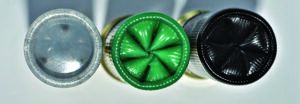
This is a full-power load at 1270 fps. In the Benelli, recoil with this round was more manageable. Just the same, it isn’t severe in the 870. With more than 1700 foot-pounds of energy and a good pattern, this is a formidable loading. If animal defense is part of the mission, this is a load to consider. Patterns ranged from 5-by-6 to 6-by-7 inches.
GUN TESTS GRADE: A-
Winchester Super-X #00 Buckshot XB1200
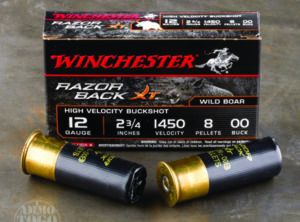 This isn’t a reduced-recoil load, but at 1145 fps, it isn’t what is usually regarded as full power. There are nine buckshot balls rather than eight in this loading. The Winchester load isn’t difficult to control. It is reliable and burns cleanly and functions the Benelli. Patterns were not the worst or the best of the test at 5.8 by 8 inches. The Benelli was a bit better at 6 by 4.5 inches, with a 6-fps velocity increase. This is an acceptable choice for home defense, but it’s not the favorite. The patterns are good and the price was right at the time of purchase.
This isn’t a reduced-recoil load, but at 1145 fps, it isn’t what is usually regarded as full power. There are nine buckshot balls rather than eight in this loading. The Winchester load isn’t difficult to control. It is reliable and burns cleanly and functions the Benelli. Patterns were not the worst or the best of the test at 5.8 by 8 inches. The Benelli was a bit better at 6 by 4.5 inches, with a 6-fps velocity increase. This is an acceptable choice for home defense, but it’s not the favorite. The patterns are good and the price was right at the time of purchase.
GUN TESTS GRADE: A-
Hornady Varmint Express #4 Buckshot 86243
The Varmint Express load is hotter than the other #4 loads at more than 1200 fps and also used 24 pellets, three more than the Remington #4 load and three fewer than the Winchester #4 buckshot loading. We had to look at the pattern in perspective. While considerably tighter than the Winchester, there are fewer pellets, but the density of the Varmint Express load is better, we thought. It also had good patterning in the Benelli at 6.8 by 3.6 inches. Patterns are larger than the Remington loading, but its velocity is higher and there is more shot. When you factor in greater velocity and penetration, this is the top #4 buckshot load. While we prefer heavier buckshot for personal defense, this load has much merit in the intended role of taking down coyotes and other predators.
GUN TESTS GRADE: A-
Fiocchi Exacta #4 Buckshot 12HV4BK
 Function was good and recoil modest with this load. Velocity is 1193 fps. With more than 1200 fps in the Benelli and a 27-pellet payload of #4 buckshot, this has the greatest energy among the #4 buckshot choices. The pattern is decent and reliable. However, in one of the patterns, a pellet landed a full 4 inches away from the others. Because the other 26 pellets were in a 7.5-by-7.5-inch square, this isn’t a bad loading.
Function was good and recoil modest with this load. Velocity is 1193 fps. With more than 1200 fps in the Benelli and a 27-pellet payload of #4 buckshot, this has the greatest energy among the #4 buckshot choices. The pattern is decent and reliable. However, in one of the patterns, a pellet landed a full 4 inches away from the others. Because the other 26 pellets were in a 7.5-by-7.5-inch square, this isn’t a bad loading.
GUN TESTS GRADE: A-
Remington Express #000 Buckshot 12B000
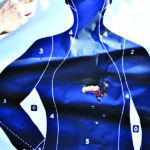
If the 34-caliber 00 is a good choice for personal defense, we felt that the 36-caliber 000 might be even better. Moving the weight up from 53.8 grains to 68 grains per pellet with an eight-count payload seemed to have the potential to increase wound potential. This is certainly true on the basis of each individual pellet, but the whole picture isn’t as impressive as we wished for. At 1050 fps, the massive 000 buckshot pellets went into a pattern of 8 by 5 inches. The Benelli went 4.5 by 4.2 inches for one pattern, but it opened up to 4.5 by 7 in another, with a single pellet increasing the group size. Generally, seven pellets went into a 4.5 by 4.5 group on average, with a single pellet skewing the average bigger. This size buckshot hasn’t seen as much development as the others. It remains a heavyweight option some will prefer.
GUN TESTS GRADE: B+
Remington Ultimate Defense Managed Recoil #4 Buckshot 12BRR4HD
The Remington load uses 21 pellets, so recoil is the least of the #4 buckshot loads. Despite this lighter momentum, the load was reliable in the Benelli self-loading shotgun. In the open cylinder Remington 870, the pattern was 10 by 10 inches at 10 yards. The Benelli’s open choke tightened things considerably at 6 by 4.5 inches, the best pattern of the #4 buckshot loads. While we decided on 00 buckshot loads, the Remington #4 is a reasonable choice for home defense.
GUN TESTS GRADE: B (BEST BUY)
Fiocchi Ammunition #00 Nickel-Plated Buckshot 12MW00BK BX
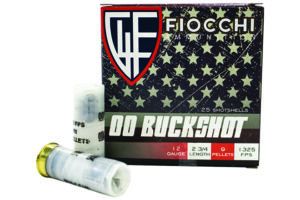
Fiocchi also offers a reduced-recoil buckshot load; this is the full-power offering. The shell is transparent and holds nine 00 buckshot pellets. This is the only load that clocked more than its factory velocity rating. At 1340 fps, it is 15 fps over factory claims. Recoil was not severe, and the load patterned at 7.5 inches by 6 inches in the Remington. It was also unusual in that the pattern was larger, or at least lopsided, in the Benelli at 8 by 3.5 inches. We would have preferred a tighter group, but then, some of the raters felt this is ideal for home defense. At any rate, this is a great buy for 10 shells at a five-shell price. This is the load to use for practice (because it was affordable at the time of purchase), even if you choose another for front-line use. We rated it down on the pattern.
GUN TESTS GRADE: B
Winchester Super-X #4 Buckshot XB124
The Winchester load burns cleanly and proved reliable in both shotguns. Recoil is in the middle of the road for the loads tested. At just over 1100 fps, this load pushes 27 pellets. While there was a cohesive center of a dozen pellets or so, there was one pellet off the man-sized silhouette out-line in the white, and the resulting pattern measured 19 inches wide by 17 inches tall, the largest pattern of the test. The Benelli gained 19 fps, and the pattern was smaller at 12 by 15 inches. The Winchester #4 load has a tight center and the largest number of pellets. It has some merit for home defense, but we rated the load down a full grade based on the large pattern. Winchester’s crimp seemed the tightest of the lot, which is important in storage and feeding in a magazine.
GUN TESTS GRADE: B
Winchester Super-X #1 Buckshot XB121
There were 16 30-caliber #1 buckshot balls in this 2.75-inch shell. The shell didn’t kick worse than 00 buck, but the pattern was larger than we like at 13.5 by 13 inches. One of the raters liked this load as a compromise between the smallest and largest shot. Some feel a larger pattern is beneficial in hitting the target with at least some of the load. But two of the #1 buckshot balls were off the silhouette body outline and in the arm. In one of the shots fired for average, three were off the outline of the target. In the Benelli’s tighter choke, the load averaged 8 by 7.5 inches, looking better. This was the only load to gain significant velocity in the Benelli, rising from 1155 to 1201 fps. We rated it down for the larger pattern.
GUN TESTS GRADE: B
Remington Express #1 Buckshot 20624

This is a lighter load than the Winchester, with 16 #1 buckshot pellets at 1082 fps on average. The pattern averaged 8 by 9 inches in the Remington and 8 by 7.5 inches in the Benelli. Usually two or three pellets were wider than the center spread, but none went into the white. This is a reasonable load for home defense, but it’s not our favorite.
GUN TESTS GRADE: B
RWS Copper-Matrix NTF #00 Buckshot 200040025
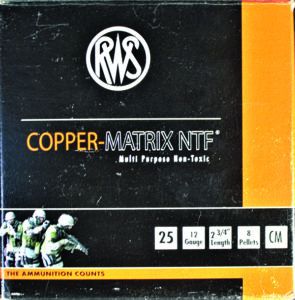
We wanted to test a frangible, so we picked the RWS load using eight frangible balls. The first thing to remember is that while there are eight balls, the weight of the charge is very light at less than 290 grains. The copper balls are designed to be safe when firing at steel targets as close as 4 feet. We did not test this, but we fired for pattern. The pattern is surprisingly tight at 4 by 6 inches, with two pellets sometime opening up the group to 4 by 8 inches. At 1370 fps, there is plenty of velocity. The load is advertised to function in gas-operated shotguns, but it did not work in the Benelli, with about 20% failures. Penetration in water was shallow due to the pellets’ light individual weight. Just the same, the 00 caliber is there and so are multiple hits. This might be a good home-defense load for apartment dwellers, but more research on penetration in building materials is needed.
GUN TESTS GRADE: B
Sellier & Bellot #00 Buckshot SB12BSG
We bought this load in a 25-shell box, which allows for cheap practice in controlling 12-gauge buckshot recoil. The Benelli ran well with this load. The pattern, at 9 by 8 inches on average, is larger than we like, and we rated it down on that score.
GUN TESTS GRADE: C
Sellier & Bellot 3-inch Magnum #00 Buckshot SB12BSA
We felt we should test at least one 3-inch shell to give some scale to the 2.75-inch loads. The longer shell nearly doubled the payload of the eight-pellet loads to fifteen 00 buckshot pellets. That is more than 800 grains of buckshot. The pattern isn’t impressive, however. The total spread in the Remington 870 was 17 by 11 inches, with one pellet off the paper. The Benelli went 15 by 11. However, 10 of the 15 pellets went into a group of 8 by 2.5 inches including four in one hole! We are certain this 3-inch load would offer devastating potential at 5 to 10 yards. The real problem is recoil. The jolt was rugged in the Remington. Another drawback was inconsistent velocity. Although the 10 shells that were fired never failed to function the Benelli, velocities ran from 807 fps to 1107 fps.
Side Loads
In addition to the loads in the main test, we also fired two other loads that are worth mentioning.
 Fiocchi Law Enforcement Rubber Buckshot
Fiocchi Law Enforcement Rubber Buckshot
This is a specialty load intended for LEO use, but widely available. Fiocchi’s website says, “At 10 meter distance, it produces 1-2 mm penetration into a seasoned pine board.” The light green cased shotshell is marketed as a less lethal alternative. We wondered if it might be useful against pests. At 575 fps and less than 50 foot-pounds of energy, this isn’t something you would want to consider for home defense, in our opinion. The pattern measured 13 by 16 inches at 10 yards. We would limit its use to pest control. It bounced on the water jugs during testing, although it split the jug and produced a trickle. We did not grade this load because it isn’t comparable to the others. For its mission, it is ideal; for anything else, it is almost useless. Fiocchi also makes a plastic pellet load and a rubber baton load, just FYI.
Winchester Defender S12PDX1
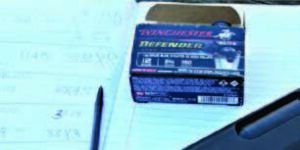 The PDX load covers several bases, with a 1-ounce slug and three 00 buckshot pellets. At 1065 fps, recoil is modest compared to some slug loads. The pattern with the slug in the center and the three balls radiating outward was 6.5 by 8 inches in the Remington. The Benelli gained 7 fps and narrowed the pattern to 4.5 by 4 inches. This is a hard-hitting load that will produce a complex wound. While it has merit, we would recommend buckshot for home defense, but perhaps having two of these in the magazine tube as the last resort would not be a bad idea.
The PDX load covers several bases, with a 1-ounce slug and three 00 buckshot pellets. At 1065 fps, recoil is modest compared to some slug loads. The pattern with the slug in the center and the three balls radiating outward was 6.5 by 8 inches in the Remington. The Benelli gained 7 fps and narrowed the pattern to 4.5 by 4 inches. This is a hard-hitting load that will produce a complex wound. While it has merit, we would recommend buckshot for home defense, but perhaps having two of these in the magazine tube as the last resort would not be a bad idea.
GUN TESTS GRADE: A
12-Gauge 2.75-Inch Shotshell Performance Data
| Load & Pellet Count | ||||
| Winchester Super-X #4 Buckshot XB124 (27) | Velocity (fps) | Energy (foot-pounds) | Average Pattern Size (in.) | Water Penetration (in.) |
| Remington 870 Pump | 1114 | 1533 | 19x17 | 15 |
| Benelli M4 Semi-Auto | 1133 | 1585 | 12x15 | 15 |
| Remington Ultimate Defense Managed Recoil #4 Buckshot 12BRR4HD (21) | Velocity (fps) | Energy (foot-pounds) | Average Pattern Size (in.) | Water Penetration (in.) |
| Remington 870 Pump | 1153 | 1277 | 10x10 | 16 |
| Benelli M4 Semi-Auto | 1166 | 1306 | 6x4.5 | 16 |
| Hornady Varmint Express #4 Buckshot 86243 (24) | Velocity (fps) | Energy (foot-pounds) | Average Pattern Size (in.) | Water Penetration (in.) |
| Remington 870 Pump | 1203 | 1542 | 11x10 | 13.5 |
| Benelli M4 Semi-Auto | 1219 | 1584 | 6.8x4.5 | 13 |
| Fiocchi Exacta #4 Buckshot 12HV4BK (27) | Velocity (fps) | Energy (foot-pounds) | Average Pattern Size (in.) | Water Penetration (in.) |
| Remington 870 Pump | 1193 | 1758 | 8x9 | 14 |
| Benelli M4 Semi-Auto | 1212 | 1816 | 7.5x7.4 | 14 |
| Winchester Super-X #1 Buckshot XB121 (16) | Velocity (fps) | Energy (foot-pounds) | Average Pattern Size (in.) | Water Penetration (in.) |
| Remington 870 Pump | 1160 | 1912 | 13.5x13 | 12.5 |
| Benelli M4 Semi-Auto | 1211 | 2084 | 8x7.5 | 12.5 |
| Remington Express #1 Buckshot 20624 (16) | Velocity (fps) | Energy (foot-pounds) | Average Pattern Size (in.) | Water Penetration (in.) |
| Remington 870 Pump | 1082 | 1664 | 8x9 | 13 |
| Benelli M4 Semi-Auto | 1089 | 1685 | 8x7.5 | 13 |
| Fiocchi Ammunition #00 Nickel-Plated Buckshot 12MW00BK BX (9) | Velocity (fps) | Energy (foot-pounds) | Average Pattern Size (in.) | Water Penetration (in.) |
| Remington 870 Pump | 1340 | 1930 | 7.5x6 | 18-20 |
| Benelli M4 Semi-Auto | 1352 | 1965 | 8x3.5 | 18-20 |
| Remington Managed-Recoil #00 Buckshot RL12BK00 (8) | Velocity (fps) | Energy (foot-pounds) | Average Pattern Size (in.) | Water Penetration (in.) |
| Remington 870 Pump | 1109 | 1174 | 1.8x1.5 | 16 |
| Benelli M4 Semi-Auto | 1116 | 1189 | 1.7x1.6 | 16 |
| Hornady Critical Defense #00 Buckshot 86240 (8) | Velocity (fps) | Energy (foot-pounds) | Average Pattern Size (in.) | Water Penetration (in.) |
| Remington 870 Pump | 1254 | 1501 | 4x3 | 18 |
| Benelli M4 Semi-Auto | 1267 | 1533 | 4.5x2.8 | 18 |
| Hornady American Gunner #00 Buckshot 86274 (8) | Velocity (fps) | Energy (foot-pounds) | Average Pattern Size (in.) | Water Penetration (in.) |
| Remington 870 Pump | 1226 | 1435 | 4.3x5.5 | 18 |
| Benelli M4 Semi-Auto | 1238 | 1463 | 4.4x7.5 | 18 |
| Hornady Black #00 Buckshot 86249 (8) | Velocity (fps) | Energy (foot-pounds) | Average Pattern Size (in.) | Water Penetration (in.) |
| Remington 870 Pump | 1270 | 1540 | 3x5 | 19 |
| Benelli M4 Semi-Auto | 1290 | 1589 | 3x7 | 19 |
| Winchester Super-X #00 Buckshot XB1200 (9) | Velocity (fps) | Energy (foot-pounds) | Average Pattern Size (in.) | Water Penetration (in.) |
| Remington 870 Pump | 1145 | 1409 | 5.8x8 | 18 |
| Benelli M4 Semi-Auto | 1151 | 1424 | 6x4.5 | 18 |
| Federal Ammunition #00 Buckshot XLE132-00 (9) | Velocity (fps) | Energy (foot-pounds) | Average Pattern Size (in.) | Water Penetration (in.) |
| Remington 870 Pump | 1233 | 1634 | 3x1.5 | 20 |
| Benelli M4 Semi-Auto | 1248 | 1674 | 3.8x3 | 20 |
| Remington Express #00 Buckshot 20620 (9) | Velocity (fps) | Energy (foot-pounds) | Average Pattern Size (in.) | Water Penetration (in.) |
| Remington 870 Pump | 1270 | 1734 | 6x7 | 20-22 |
| Benelli M4 Semi-Auto | 1289 | 1786 | 5x6 | 20-22 |
| RWS Copper-Matrix NTF #00 Buckshot 200040025 (8) | Velocity (fps) | Energy (foot-pounds) | Average Pattern Size (in.) | Water Penetration (in.) |
| Remington 870 Pump | 1370 | 1066 | 10x12 | 10 |
| Benelli M4 Semi-Auto* | 1359 | 1083 | 6x4 | 10 |
| Remington Express #000 Buckshot 12B000 (8) | Velocity (fps) | Energy (foot-pounds) | Average Pattern Size (in.) | Water Penetration (in.) |
| Remington 870 Pump | 1050 | 1332 | 8x5 | 22 |
| Benelli M4 Semi-Auto | 1044 | 1316 | 4.5x7 | 22 |
| Winchester Razorback XT #00 Buckshot S12RB00 (8) | Velocity (fps) | Energy (foot-pounds) | Average Pattern Size (in.) | Water Penetration (in.) |
| Benelli M4 Semi-Auto** | 1350 | 1717 | 4.5x2.5 | 24 |
| Sellier & Bellot #00 Buckshot SB12BSG (9) | Velocity (fps) | Energy (foot-pounds) | Average Pattern Size (in.) | Water Penetration (in.) |
| Remington 870 Pump | 1055 | 1197 | 9x8 | 22 |
| Benelli M4 Semi-Auto | 1060 | 1208 | 5x7.5 | 22 |
| Sellier & Bellot 3-in. Magnum #00 Buckshot SB12BSA (15) | Velocity (fps) | Energy (foot-pounds) | Average Pattern Size (in.) | Water Penetration (in.) |
| Remington 870 Pump | 1005 | 1810 | 17x11 | 22 |
| Benelli M4 Semi-Auto | 1000 | 1800 | 15x11 | 22 |




























Wondering about Federal LE133. It was the best we tested for my former agency.
What about T or F goose loads?
Well done but maybe next time include the Federal LE133.